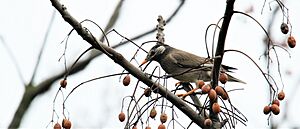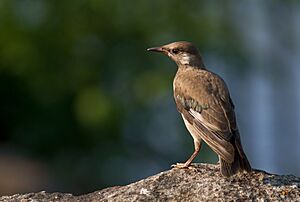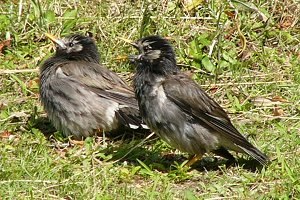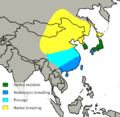White-cheeked starling facts for kids
Quick facts for kids White-cheeked starling |
|
|---|---|
 |
|
| Adult male (left) and female | |
| Conservation status | |
| Scientific classification | |
| Genus: |
Spodiopsar
|
| Species: |
cineraceus
|
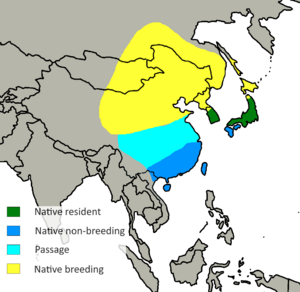 |
|
| Synonyms | |
|
Sturnus cineraceus |
|
The white-cheeked starling (Spodiopsar cineraceus) is a common bird found in eastern Asia. It belongs to the starling family and is a type of passerine bird, which means it's a perching bird. These birds are well-known in many parts of their home range.
Contents
About the White-Cheeked Starling
The white-cheeked starling is also sometimes called the grey starling. Scientists have studied these birds for a long time. They sometimes change how birds are grouped as they learn more. This starling used to be in a group called Sturnus. But now, based on new studies, it's in a group called Spodiopsar. This group also includes the red-billed starling.
What Does a White-Cheeked Starling Look Like?
These starlings are about 24 centimeters (about 9.5 inches) long. That's roughly the length of a standard ruler!
- Adult Males: They are mostly dark grey-brown. Their belly is a bit lighter. They have a white stripe across their lower back, called the rump. Their head is blackish with bright white cheeks and a white forehead. You can also see white edges on their tail feathers and white spots on their wing feathers. Their legs are light orange, and their beak is orange with a black tip.
- Adult Females: They look a lot like the males, but their colors are usually a bit lighter and not as bright.
- Young Birds (Juveniles): When they are young, these starlings are brown. Their cheeks and rump are pale, and their beak doesn't have a black tip yet.
The white-cheeked starling has a loud and strong call. It sounds like a series of harsh, creaking noises.
Where Do White-Cheeked Starlings Live?
White-cheeked starlings breed in several countries in Asia. This includes central and north-east China, Korea, Japan, and south-east Siberia.
When winter comes, birds from colder areas fly south. They go to warmer places like southern and eastern China, South Korea, southern Japan, Taiwan, and northern Vietnam. Sometimes, a few birds might fly even further, reaching places like the Philippines, Thailand, and Myanmar. There was even one record of a starling in Homer, Alaska in 1998, which likely arrived there by hitching a ride on a ship!
These birds can live in many different places. They like woodland areas, farmland, and open fields. They have also learned to live in cities, making homes in parks and gardens. They are most often found in lower areas, usually below 700 meters (about 2,300 feet) in Japan.
What Do White-Cheeked Starlings Eat?
White-cheeked starlings eat a variety of foods. Their diet includes different kinds of fruit. They also enjoy eating insects, such as mole crickets.
Life Cycle and Reproduction
The breeding season for white-cheeked starlings is from March to July. During this time, a pair of starlings will often lay two sets of eggs.
They build their nests in safe places. These can be holes in trees or buildings. They also use nestboxes that people put up. The female starling lays between four and nine eggs. The parents then sit on the eggs to keep them warm, a process called incubation. This lasts for 14 to 15 days. After the eggs hatch, the young birds stay in the nest for another 13 to 15 days. Then, they are ready to leave the nest and fly on their own, becoming fledglings.
Images for kids



